1: Traditional Concepts
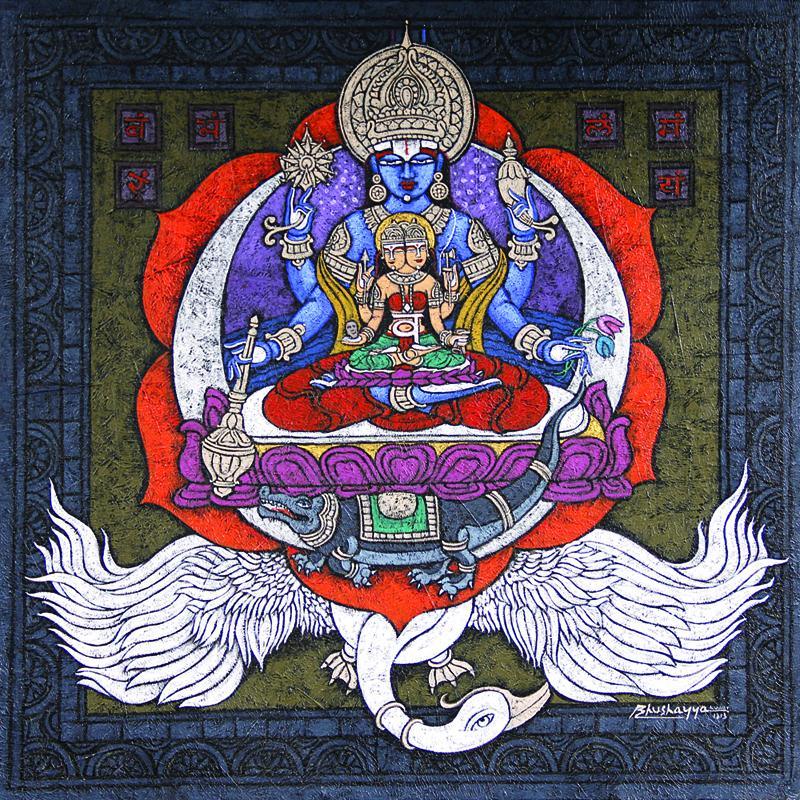
Svadhishthana chakra is often called the “seat of my own self” and is connected to the water element.
Location and Role: The Svadhishthana chakra is in your abdomen, lower back, sexual organs, and sacrum. It’s tied to our emotions, creativity, and purity. When balanced, it brings joy, faith, and energy.
Driving Force: The main emotion here is Kama, or Desire. The basic needs like food, reproduction, and sleep give rise to attachment and emotions.
Vibration and Element: The subtle sound (Bija Mantra) for this chakra is Vam (लँ). Its element, Water, governs the body’s liquids and the subconscious mind, where our past experiences (samskaras and karma) are stored.
Emotional Healing: Just like water, our emotions are always changing. By meditating on Svadhishthana, we can safely face and release negative emotions, leading to greater wisdom and self-control.
Symbolism: It’s often visualized as a white crescent moon within a lotus, representing purity and beauty. This moon’s inner and outer circles symbolize our conscious and unconscious minds, as well as our positive and negative emotions.
Svadhishthana chakra is a crucial energy point for understanding and managing our emotions, boosting creativity, and advancing on our spiritual journey.
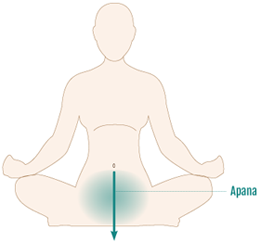
The vayu or vital breath of Svadhishthana is Apana.
The Bandha for Muladara is uddíyána bandha (inward and upward abdominal contraction).
Prana: Svadhishthana, Sacral chakraDeities and Symbolism of Svadhishthana Chakra
The Svadhishthana chakra is deeply intertwined with several Hindu deities and their associated symbols, each representing a facet of its spiritual and emotional significance.
Varuna (God of Water and Morality)
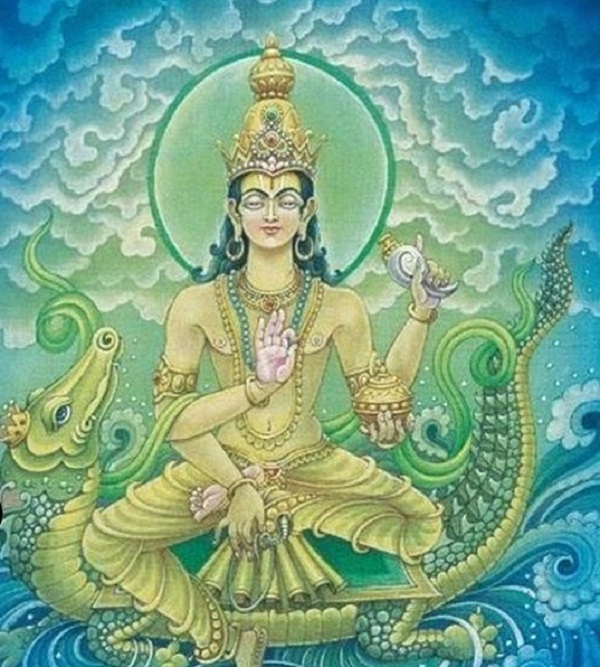
- Role: An ancient Vedic god of water, rain, clouds, sea, and rivers, Varuna possesses all oceanic knowledge and permeates existence, sustaining life with rain. He has a thousand eyes, overseeing the world and dispensing justice.
- Symbolism: He wields a lasso (pasha) to bind and control negative desires like greed, anger, infatuation, jealousy, and ego. He also holds a vessel of precious gems, symbolizing wealth. His Makara mount signifies both hidden negative emotions and the ability to balance conscious and subconscious minds.
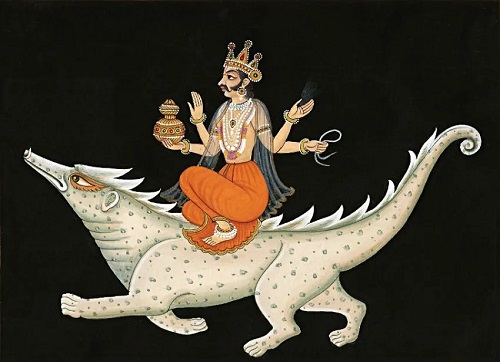
The Makara (Water Monster/Vehicle)
- Symbolism: This half-land, half-sea creature embodies the duality of emotions. In lower consciousness, it represents hidden negative emotions that cause irritability. In higher states, it signifies the balance between the conscious and subconscious. Makara also act as guardians of spiritual thresholds. It is the vehicle for Varuna and the river goddess Ganga.
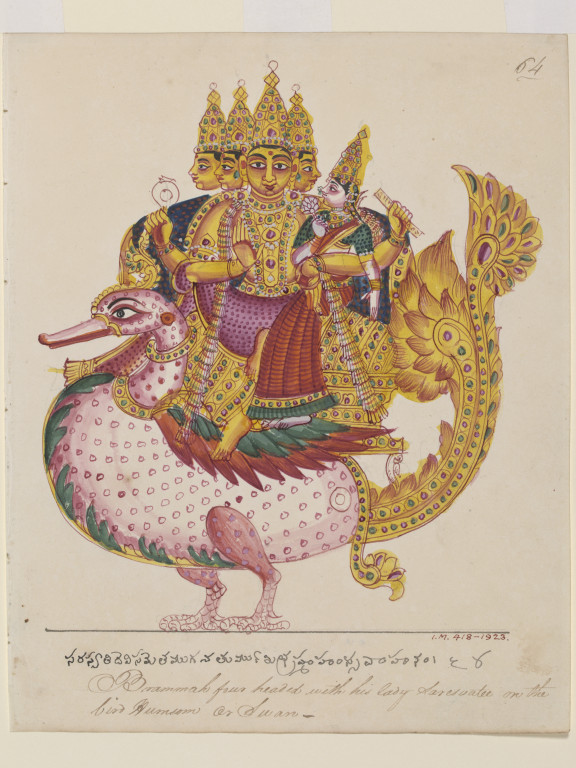
Brahma (Creator, Consciousness, Father of Knowledge):
- Role: The creator deity, associated with consciousness and the intellect. His four heads symbolize his intense gaze upon Saraswati, his creation, highlighting the egoistic love of the creator for his creation.
- Symbolism: His relationship with Saraswati signifies how knowledge interacting with creation drives further development.
- As we learn to navigate our feelings and emotions with skill, we learn to ride their waves with non-attachment.
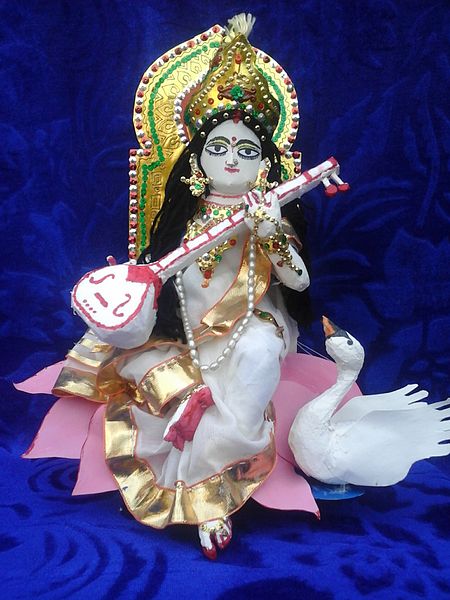
Saraswati (Goddess of Knowledge, Wisdom, and Arts):
- Role: The goddess of knowledge, learning, wisdom, and fine arts, she provides the energy to bring Brahma’s cosmic vision into being. Her name means “to flow,” reflecting the ability to flow with life’s challenges through wisdom.
- Symbolism: Depicted with four arms holding a veena (music), a book (knowledge), mala beads (meditation), and a pot of sacred water (purification). Her reciprocal relationship with Brahma emphasizes that creation requires both abstract consciousness (Brahma) and tangible knowledge/action (Saraswati). Both Brahma and Saraswati ride the Hamsa (swan), symbolizing intelligence, purity, and wisdom.
There are two “jewels” hidden within the Svadhishthana Chakra: ICCHĀ SHAKTI (willpower) and KRĪYA SHAKTI (vigour/drive), which can be utilized for personal growth.
Vishnu (Preserver, Remover of Obstacles):
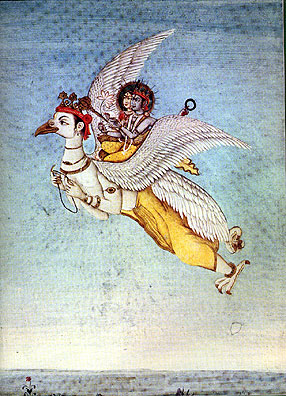
- Role: Vishnu means “to penetrate,” signifying the ability to discern truth. He is Hari, the remover of obstacles and negative energies, maintaining the balance of good and evil.
- Symbolism: He is typically bright blue and adorned with jewels, including the Kaustubha gem (consciousness). His four arms hold:
- Conch: Represents the primeval sound ‘Om’ and control over the five elements.
- Sudarshana Chakra (Spinning Disc): A celestial weapon that destroys evil, symbolizing auspicious perception achieved through observing thoughts, emotions, and actions.
- Lotus Flower: Symbolizes glorious existence and liberation.
- Mace: Represents mental and physical strength.
Vehicle: Vishnu rides Garuda (eagle), symbolizing the five vayus (life forces).
The Vrittis of Svadhisthana
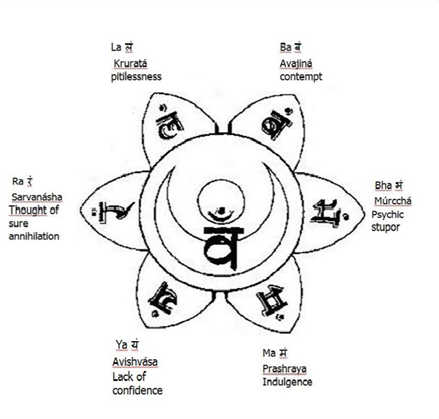
ba बं Avajina: Indifference.When one neglects something which may have some value, it is called avajina.
bha भं Múrcchá: loss of consciousness.
Murccha means to lose one’s common sense under the hypnotic spell of a particular ripu or mind weakness. There are 6 ripu: Kama (lust), krodha (anger), lobha (greed), mada (arrogance), moha (delusion), and matsarya (jealousy).
ma मं Prashraya: Love, affection, respect, courtesy, civility, politeness, humility.
ya यं Avishvása: Lack of confidence, self-doubt.
Aviśvāsa refers to distrusting someone or not inspiring confidence.
ra रं Sarvanásha: Thought of sure annihilation, fear, defeatism, purposelessness.
la लं Kruratá: cruelty, pitilessness or merciless.
Ways to overcome negative aspects in Svadhishthana
You’ve provided a fascinating approach to understanding and overcoming negative emotions within the Svadhishthana chakra, connecting them to specific “acoustic roots” or vibrations. This framework offers practical strategies for emotional well-being and spiritual growth.
Overcoming Negative Emotions in Svadhishthana Through Acoustic Roots and Practice
The Svadhishthana chakra is a hub for various challenging emotions, but by chanting their “acoustic roots” outloud or internally, and applying targeted practices, we can transform these feelings and cultivate positive qualities.
1. Ba (बं) – Avajiná (Indifference, Contempt, Disdain)
BABa is the acoustic root of Avijina.
- The Challenge: This emotion manifests as belittling others, feeling jealous of their happiness and achievements, or being indifferent to their suffering. It reflects a lack of compassion and an inclination to disregard the efforts or well-being of others.
- Solution: To overcome this, cultivate empathy and compassion. Instead of jealousy, genuinely be happy for others’ good fortune. Develop sympathy for those in misery and offer help when possible. Be supportive of positive actions and never ignore harm to society. Practice humility and strive to understand others’ feelings.
2. Bha (भं) – Múrcchá (Lack of Common Sense, Psychic Stupor, Gullibility)
BHABha is the acoustic root of Murccha.
- The Challenge: Múrcchá describes losing your good judgment under the influence of the six “mind enemies” of lust, anger, greed, arrogance, delusion and jealousy. It also refers to a superficial understanding of spirituality, where you might focus only on physical benefits (like in yoga) instead of deeper spiritual truths.
- Solution: To counteract this, practice Pratyáhára Yoga, which involves withdrawing the senses and focusing inward to connect with your true self. If formal yoga techniques aren’t familiar, engaging in kirtan (devotional singing) can help. Seek genuine spirituality, direct your mind towards truth through meditation and pranayama, and actively work to overcome ignorance, recognizing that a purely physical reality (Maya) can veil deeper truths.
- By following these practices, you can prevent your mind from being swayed by Múrcchá, leading to greater clarity and genuine spiritual insight.
3. Ma (मं) – Prashraya (Over-Affection, Indulgence)
MAMa is the acoustic root of prańásha.
- The Challenge: While seemingly positive, excessive affection can lead to over-indulgence, making others dependent or allowing them to exploit you. This “kindness” can become a weakness when it hinders another’s growth or encourages manipulation.
- Solution: The key is to temper compassion with good judgment. Learn to set boundaries and say “no” when necessary. Offer help incrementally and observe if it’s genuinely utilized and appreciated, rather than blindly providing assistance that fosters dependency.
4. Ya (यं) – Avishvása (Lack of Confidence, Self-Doubt)
YAYa is the acoustic root of avishvása vrtti.
- The Challenge: While healthy doubt can aid decision-making, chronic self-doubt erodes confidence, leading to uncertainty and a lack of inner peace. It can manifest as procrastination or blaming external factors for personal problems. When we have no doubt we have certainty, peace and composure.
- Solution: To build confidence, cultivate self-faith and trust in the universe. Take action, overcoming obstacles one step at a time, and affirm to yourself, “I can do this.” Learn from past errors without letting them define you, extracting lessons and then releasing the negative experience. Take responsibility for your challenges, practice self-kindness, forgive yourself, and use criticism as a tool for improvement rather than taking it to heart. Trust your instincts in uncertain situations.
5. Ra (रं) – Sarvanásha (Thought of Sure Annihilation)
RARa is the acoustic root of sarvanásha
- The Challenge: This is a state of profound defeatism, fear, and purposelessness, where everything seems lost and nothing brings joy. It can manifest as widespread panic or deep depression.
- Solution: Combat this with the powerful auto-suggestion: “I have come to win. I am destined to win.” Embrace a winner’s mindset and encourage others to do the same. Reject negative self-talk. Through meditation, gain control over your thoughts and feelings. Understand that emotions are temporary; observe them (e.g. “I feel sad” instead of “I am sad”) to prevent them from consuming you. Practice mindfulness to stay grounded in the present moment.
6. La (लं) – Kruratá (Cruelty, Pitilessness, Mercilessness)
LALa is the acoustic root of krurata.
- The Challenge: This emotion involves a lack of compassion, leading to actions that can harm living beings or the environment. It’s about being hard-hearted or indifferent to suffering.
- Acoustic Root & Solution: The acoustic root is La. The core remedy here is compassion. While self-preservation is natural, it should be practiced with gratitude and kindness. When faced with cruelty in others, try to understand that it often stems from their own suffering, fostering pity rather than anger. Practice forgiveness to liberate yourself from hatred. This understanding allows for a more harmonious existence with all life.
By focusing on these specific practices and the vibrational qualities of each emotion’s acoustic root, you can actively transform the negative aspects of your Svadhishthana chakra, leading to increased joy, cheerfulness, faith, self-confidence, and vigor.
